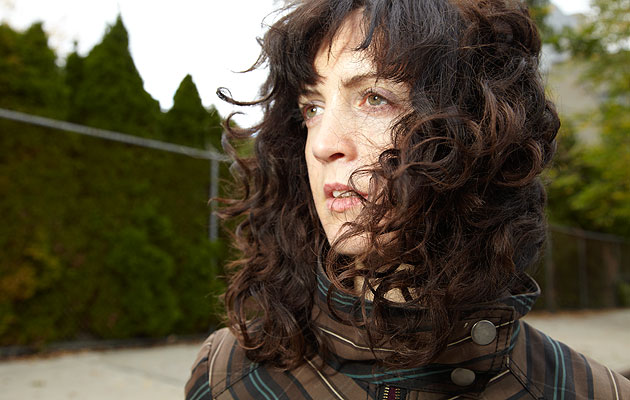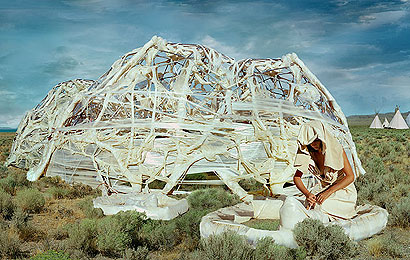|
|
||
|
The nomads in Mary Mattingly’s post-apocalyptic landscapes carry their homes on their backs. The artist is now putting her high-tech designs into production. In the spring of 2000, Mary Mattingly went on a camping trip to the Oregon coast with a few friends. As a New England transplant who had only recently moved west, Mattingly was struck by the vast, seemingly unregulated landscape. There was no ranger, no place to check in, so her group struck camp where they pleased, on a cliff overlooking the ocean. During the middle of the night, they were awakened by snarling animals circling their tent. Mattingly and her friends huddled together, terrified; whenever one of the creatures approached and pushed at the fabric with their paws, someone would yell until it went away. Mattingly’s impression of the wilderness as a tame, serene setting was irrevocably reversed; and she was left determined to overcome her fear and lack of knowledge about how to survive in the great outdoors. I meet Mattingly, a petite, wavy-haired brunette, in her studio, which occupies an old industrial building on a cobblestone street in Brooklyn, just steps away from the East River. Mattingly moved to New York in August 2001, and a month later, on 11 September, she learned that an urban environment is no more predictable or safe than the bush. Inspired by the surging sense of community among New Yorkers following the terrorist attacks on the World Trade Center, Mattingly came to view community relations as essential to survival, perhaps even more essential than shelter. “I began thinking about a dystopian future,” she says, “the result of multiple technologies taking over and making people separate, even afraid of others.” Inspired by this realisation, as well as her desire to master survival skills, Mattingly embarked on the creation of an ongoing art project, Wearable Homes. The “homes” look a bit like army fatigues, and consist of three layers: an outer layer to counter desert heat and sun, an inner layer that blows up into a flotation device, in case of flooding, and a sub-arctic layer, for warmth. An expandable pouch lies close to the stomach, for storage, and 30 pill pockets are sewn on the outside of the suit, for micro-sized nutrients. There is also a hood, which includes a celcerform, a device used to shrink cancerous growths, to protect the wearer from excessive cell phone use.
“Essentially,” Mattingly explains, “the Wearable Homes do everything a home might do.” That is, they provide users with warmth and shelter – solar panels even power an electric blanket in one of the suits. The project caught the attention of Black Umbrella, a new company based in New York that promises to create “practical, efficient disaster plans for individuals, couples and families”. For $750 you can buy “Basic Family Preparedness” (“Advanced Family Preparedness” will cost you the same again). They commissioned Mattingly to design a lightweight backpack that opens up into a sleeping bag and has plenty of room for storing other necessities. The Wearable Homes are continually being refined and tweaked, particularly as new fabrics or portable resources come on the market. For the moment, they are made from patterned camouflage, but Mattingly fantasises about a future when “the actual Wearable Home can be printed from a 3D printing station”. If and when this happens, she notes in an email, “the fabrics will include phase-change materials to regulate body temperature; medicating, UV-protective, anti-bacterial/anti-microbial agents; mosquito and insect repellents; and moisturisers encapsulated inside the fabric”. Mattingly has tested her nomadic outfits on three-week survival trips into the desert and, in 2009, she built the Waterpod, a self-sufficient barge, complete with a garden and solar panels to generate electricity. For four months of that summer, the Waterpod, which was constructed of recycled wood and other materials, bobbed around New York harbour, evoking the energy-generating structures of Buckminster Fuller and Robert Smithson’s floating island. Mattingly was driven to create this project in response to rising tides (the flotation device on the Wearable Homes also takes a waterlogged future into consideration), yet it also ties into her recurring concern about ways to support and engender community during a period of societal collapse. In fact, Mattingly is now committed to making the homes so that they connect to others. The hoods serve not only to hide one’s identity, as uniforms they also have a unifying effect, to reinforce the group dynamic. “I’m interested in exploring a future based on community, rather than individuality,” she says. The objects in Mattingly’s studio give a sense of where she’s headed next – she bought an army parachute off eBay, and is using it as a template for the connected homes. Meanwhile, a glimpse of her bookshelf reveals titles as varied as Henry David Thoreau’s Walden and JG Ballard’s Drowned World. However, the difference between these two books, one rhapsodising the transcendence of nature, and the other predicting environmental disaster caused by global warming, is less clear than one might think. Both celebrate a return to primitive life, or pre-civilisation, as a way of having true independence, that is, freedom. And from that perspective, the Wearable Homes are less a forecast of doom than a recipe for liberation. |
Image Jen Campbell
Words Claire Barliant |
|
|
||
|
|
||





















